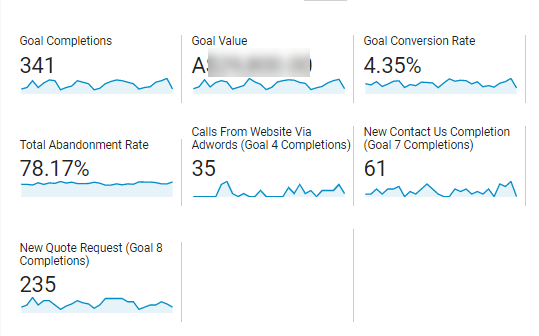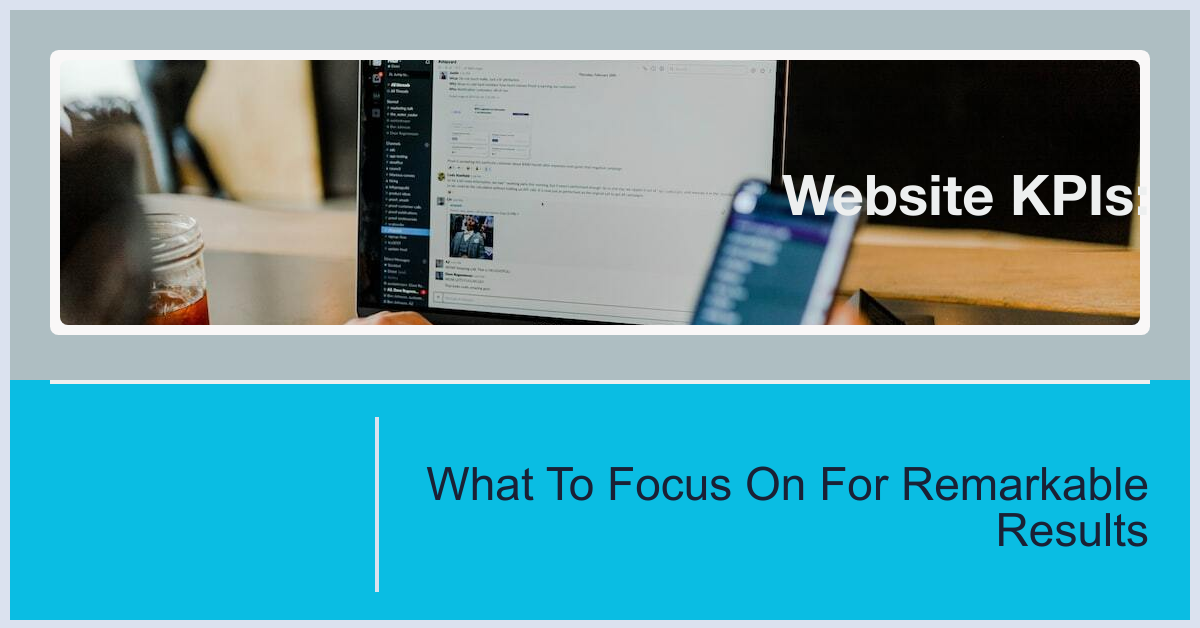You have a home services business website, and people are visiting it. But do you know what's happening on the website? Do you know how many leads it’s actually producing for your plumbing business?
I will explore that more in this blog post, and the post will help you know what you need to ask your web developer to track for you.
More...
What’s Important To Measure?
What’s important depends on what you are trying to achieve from your website and marketing. If you are like most plumbers, you want new leads - so phone calls and contact form completions will be vital to you.
As a plumber, I don't think you should settle for soft measures like engagement in visits as the primary measure of success. Sure, it helps that many people know about you, but most importantly, you want to convert visitors to leads by your website.
Overview Of Important Website Measures
Here are some website measures that you should be looking at and learning from.

Some people will say you should be tracking things like site speed, SEO optimsation and core web vitals. These things are all very interesting for SEO and web people but they are only a step in the dance to the measures above and are really just noise for a plumbing business owner.
For example, if your site is slow you'll have a high bounce rate and low time on site, if it’s not optimised well on a page by page basis your traffic will be low.
Conversions Are The Most Important Measure
How much conversion is happening on your website? At the end of the day, the job of your website is to act as a 24/7 lead generator.
So you need to know how many people come to your site and then contact you.
Getting someone to contact you from your website is a conversion, and the conversions can happen in several ways:
- Phone calls
- Booking a service
- Splitting a contact us form
- Requesting a quote
You should measure all of these in your website analytics. That way, you can see what your conversion rate is. A plumbing website with a conversion rate of higher than 5% is doing pretty well.

Call Tracking - A Gap
Have you set up call tracking? Most plumbers have not set up phone call tracking on their websites, so they don't know how many phone calls the website generates.
I know you can get a feel for the number of calls from your website, especially if it’s only a few per week. But doing it that way is not very scientific, and you don't know where those call the coming from in terms of sessions and traffic sources because there's no way of connecting the call back to the source of the visit on the website without phone call tracking.
Spend the money on call tracking to save ten times more on wasted advertising.
Conversion Rate and Cost
If you have enough traffic, it's helpful to understand where your conversions are coming from and how much they cost to get them there.
So, for example, it's essential to understand:
- Ift all the traffic that comes from your website from (let’s say) Instagram doesn't convert at an outstanding rate
- Or that in contrast, your conversion rate for Google Ads is ten times higher than the conversion rate of social media

Having this type of data allows you to allocate a cost to generating the traffic. Then you can calculate the cost of getting the lead so you know where you can allocate your marketing budget and time. That’s a handy insight.
Other KPI Measures To Track On Your Plumbing Website
There's a bunch of handy measures that contribute to the conversion rate and the cost-per-conversion.
Traffic
How much traffic your website is getting? You can see this via sessions in Google Analytics.
You can see sessions for both returning visitors and new visitors. What's essential here depends on your goals.
As a plumber looking for new leads, new visitor sessions likely are the most important.
It's also vital to create a segment in Google Analytics to measure traffic in your service area. For example, if you are a plumber in the Northern Beaches area of Sydney, traffic from the UK and the USA is irrelevant obviously.
And in the same way, traffic from any other city in Australia is irrelevant. If you don't want to be driving all over western, southern Sydney, that traffic is also not significant in the assessment.
Don’t be fooled by looking at top-line traffic only.
Traffic Source
Where is your traffic coming from? It's also important to understand where your visitors are coming from.
Google Analytics makes it very easy for you to see how much traffic is coming from organic or direct or paid, for example.
It's also possible for you to see much traffic comes from Facebook and Instagram. It’s often bugger all!

You must understand the effect of your marketing activities to see where your traffic is coming from. For example, you will probably generate a lot of traffic from your Google My Business (GMB) listing.
You can track this properly by having a tracking number on the GMB listing as the primary number. And you can track links from GMB to your website by using Google UTM tracking links.
You can also use Google UTM tracking links or other ways of tracking offline activity. There’s no need to fly blind with your marketing activity.
Engagement and Behaviour
Engagement and behaviour metrics should be important to you because they're important to Google and your website’s Google ranking.

What would Google prefer to see?
- People coming to a search engine result page, clicking links to your website, staying on the site for a decent a this is about the time and looking at several pages, or
- People coming to a search engine result page clicking through to your website and leaving almost immediately.
Because they want to be helpful to users, the first behaviour is what they are looking for. The two most important measures here are bounce rate and engagement.
I think it's essential that you understand those for each of your entry and exit pages. So, for example, if you have a page about bathroom plumbing and people arrive on it and it has a high bounce rate, that page needs improvement.
Also, if you have a page on the website where people come to and leave pretty quickly and at high rates, that page needs to be improved.
Bounce Rate
Bounce rate is the percentage of visitors to leave after seeing only the page they came to. A high bounce rate can be good or bad, depending on what's going on with the traffic.
For example, if you are driving traffic to a landing page from Google Ads and the page is a complete answer to their search query, and you get good conversion from that page, you can expect a high bounce rate. And this is ok.
However, if you see people coming to your homepage from Google search (organic), and they are leaving almost straight away, and if you have a bounce rate greater than 60%, you have issues that you need to address with that page.

Arriving Pages
Which page is the traffic coming into?
It's helpful to understand which page your traffic is coming into. Is most of your traffic just ending up on the homepage and then having to navigate through to the website? That suggests your other pages about services and locations aren't strong enough for Google to show them directly.
Are you getting a lot of traffic from some locations or about a particular service that you offer?
Leaving Pages
It's also beneficial to understand which pages are not satisfying your website visitors.
You can do this by looking at the exit pages from your website. So, for example, are many people getting to your homepage then going to your about us page and leaving?
Engagement Measures
How engaging your website is with your visitors? Two metrics are essential here. They are the:
- Average time spent on the site, and
- The number of pages your visitors look at.
For example, you could expect someone looking for a plumbing service to come to your home page, go to your service page, and check out your about page, giving a 3-page visit and probably 2 to 3 minutes on the site.
The people are only looking at one page and leaving after less than 15 seconds; then you've certainly got issues you must address.
Visitor Types
Who is visiting your website?
It's not just essential to measure the number of visits to your website from your service area. It's also crucial to know who is actually visiting your website.
It’s essential to understand how many people from your service area are visiting your site. There's no point in tracking the number of people from Russia and the USA visiting your plumbing website if it's in Sydney and you're only servicing western Sydney, for example.
Google also provides useful demographic and in-market audience information about the visitors to your site. You can see, for example, their gender, their age, and a whole lot of information about their interests and what they're doing at the time.

Google has some very useful in-market audiences that relate to plumbers these are;
- Home & Garden/Home & Garden Services/Plumbing Services
- Home & Garden/Home Improvement/Plumbing Fixture Hardware & Parts
- Home & Garden/Home Improvement/Plumbing Fixtures
- Home & Garden/Home Improvement/Kitchen & Bathroom Cabinets
You can find out how to use them for building your business in this post about alternatives to Google Search Ads
How Do You Do All The Tracking?
Getting the tracking sorted out it's pretty easy, and for the most part, the tools you need are free.
The tools I recommend you use are:
- Google Tag Manager to install all of the code on the website
- Google Analytics to do all the tracking of traffic sources and conversions
- Google's free reporting dashboard tool - Google Data Studio
- Google Search Console linked correctly to your Google Analytics
- If you're using Google Ads to generate plumbing leads, then connect that to your Google analytics as well. And if you want to do conversion testing, use the free Google Optimise tool.
Improving Conversion Rates
If the conversion rate on your website is not reasonable, you can improve conversions on your website in a scientific way by A/B testing changes to the website.
What’s not good? I suggest that anything less than 5% is open for improvement, and in reality, nearly all plumbing sites, including those with excellent conversion rates, can benefit from conversion testing.
For example, you can test different images, value propositions, offers, page lengths - almost anything by creating an AB test using the free Google Optimise tool to run it.
There’s some real value in this because doubling your conversion rate without paying to double the traffic to your site gives you twice as many leads for the same marketing cost.
Your turn
- Do you have Google Analytics and Google Search Console set up for your website?
- Do you have phone call tracking setup? For all traffic as well as for external marketing
- Are you using UTM or other tracking links correctly and all the time?
- Do you have a dashboard that you can look at to see what's going on on your website at any time?
If that's not the case, please contact us, and we can help you out.

